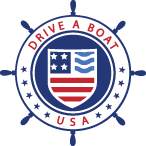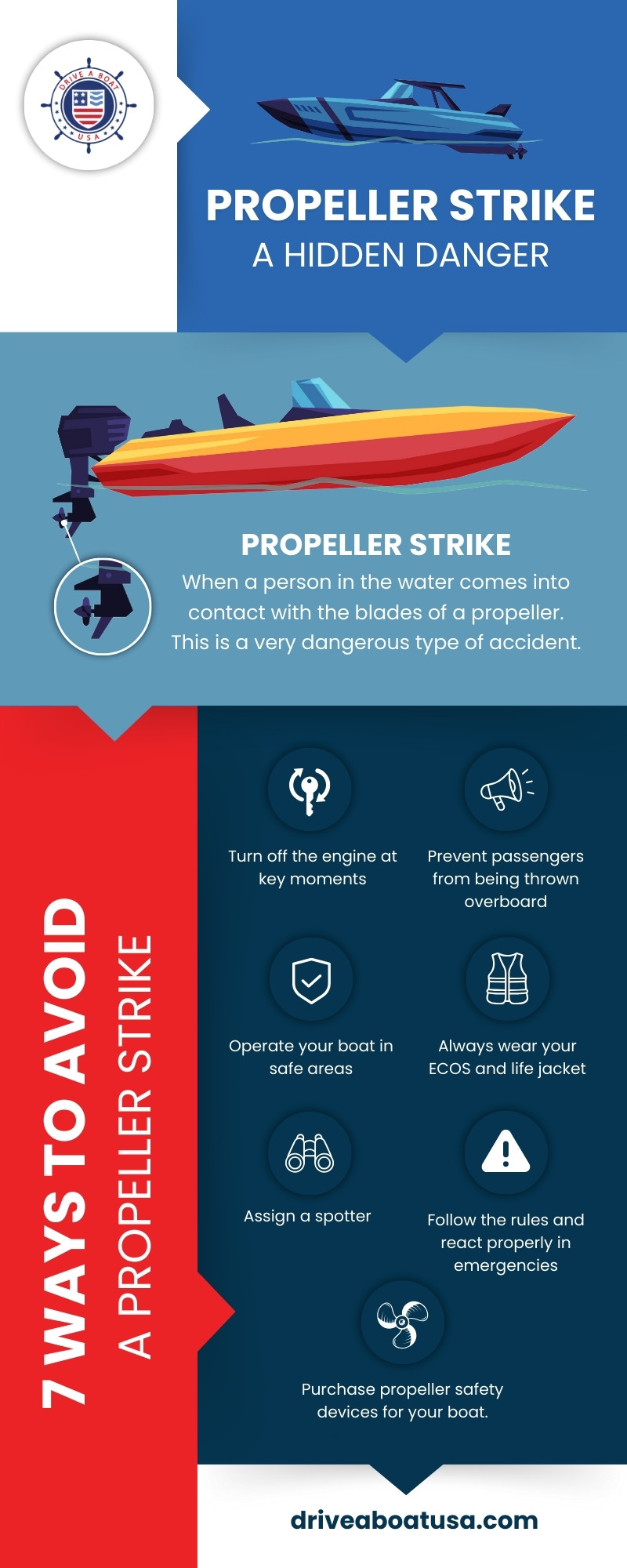Boat Propeller Strike: Avoiding Injuries and Accidents
Boat propellers pose a serious safety risk. A typical 3-blade propeller running at the average speed of between 1200 and 3200 RPM can inflict 150 impacts per second and travel from head to toe on a human being in less than a tenth of a second.
Swimmers, divers, anglers, people enjoying water sports and people who have been accidentally thrown overboard are the most vulnerable to the dangers of propeller strikes.
Statistics from the U.S. Coast Guard’s 2022 Recreational Boating Statistics (the most recent report) reveal that more than 30 people die every year as the result of a propeller strike.
Most deaths are preventable by following proper boating safety rules and using the right equipment.
What is a propeller strike?
When a person in the water comes into contact with the blades of a propeller, it is called a propeller strike. This is a very dangerous type of accident.
Boat propellers operate below the water line. They are invisible to boat operators, swimmers, skiers, and others.
Causes of propellor strike accidents
Propellers in motion create a downward and inward flow of water toward the boat’s center. People in the water near the stern can be swept into this hydrodynamic current and sucked towards the blades.
In other cases, a boat simply collides with a person in the water, as a result of operator negligence.
Propeller strike accidents occur when:
- A boat operator does not follow safe boating rules and ignores signals, signs and boating etiquette
- A crew member falls overboard
- A boat operator falls overboard. Since the boat is not being steered, it turns in a circle and can run over the operator (and anyone else) in the water. This phenomenon is known as ‘Circle of Death’.
How to reduce the risk of propellor strikes
Safe boating includes prevention. To reduce the risk of propeller strikes, make sure everyone on the boat knows where the propellers are and is aware that they pose a danger. Here are seven ways to help you stay safe when using a boat with a propeller.
1. Turn off the engine at key moments
- Never get on or off a boat while the engine is running or idling.
- Never start your boat with the engine in gear.
- Never leave the propellers spinning when a passenger is in a vulnerable situation.
- Walk around on your boat and make sure the water is clear on all sides before starting the engine.
- Make sure everyone is seated properly and there is no-one swimming near or diving from the boat.
- Do a head count to verify that everyone is on board before starting the engine.
2. Prevent passengers from being thrown overboard
- Do not allow passengers to stand.
- Do not allow passengers to sit on the transom, gunwales, seat backs or bow while underway.
3. Operate your boat in safe areas
Boat operators are responsible for the safety of people in and around their boat at all times. This includes:
- Keeping away from swimmers, divers, anglers and people doing water sports.
- Staying alert to diving flags and other signs that people are in the water.
- Slowing down when approaching busy or congested areas, and anchorages.
- Staying away from marked swimming and diving areas.
- Being extra careful when enjoying towed water activities or when near others who are doing so.
4. Always wear your ECOS and life jacket
Since 2021, you may be obliged to wear an ECOS (Engine Cut-Off Switch) on your person. This applies if your vessel:
- is under 26 feet
- is equipped with an ECOS
- has a helm that is not an enclosed cabin
- is operating on plane or above displacement speed
If a boat operator strays too far from the helm, a lanyard kill switch detaches and automatically turns off the engine.
The USCG also stipulates that all boaters must wear appropriately sized and fitted approved life jackets at all times while out on the water. A life jacket not only protects you from drowning, it also makes you visible in the water.
5. Assign a spotter
Carelessness is a major factor in propeller-related injuries and deaths.
- Choose a responsible adult to keep watch of the propeller area of the boat when people are in the water.
- Choose another passenger to keep watch of children on board and sound the alarm if a child falls overboard.
6. Follow the rules and react properly in emergencies
Follow the rules:
-
- This includes proper equipment safety checks, boat maintenance, and following guidelines for towed water sports and personal flotation devices.
- It also includes making and following rules for using swim platforms, boarding ladders and seating.
- Make sure you know how to identify warning buoys, signs identifying swimming areas, and signals for ‘diver down’, ‘passenger overboard’ and when a water skier is waiting to be picked up.
- Always make sure everyone on board is wearing a PFD.
- To be sure you have the right information, take a safe boating course!
React properly in an emergency:
-
- If someone falls overboard, immediately turn toward the person in the water so that the stern is away from them. At the same time, shift to neutral so that the boat propeller stops spinning.
- Never put your boat in reverse to pick up someone in the water. Instead, circle around.
7. Purchase propeller safety devices for your boat.
There are several devices that can be used to help prevent propellor strikes:
- Propeller guard: A physical barrier that fully or partially surrounds the propeller, such as a cage or ring guard.
- Electronic sensors: A wireless sensor worn by boaters that either triggers an alarm or shuts off the engine if someone falls overboard.
- Interlocks: These automatically sound an alarm or turn off the engine when triggered. A ladder interlock, for example, turns off the engine when someone uses the ladder.
- Anti-feedback steering: This can be used to lock the boat steering system so that the vessel will not circle around if the operator falls overboard.
You could also consider using an alternate form of propulsion, such as a jet drive or pump jet.
Do a safe boating course with Drive A Boat USA
Safe boating is all about enjoying your day on the water. You can’t be too careful when dealing with high-powered boating equipment, as any moving machinery poses a real risk to human safety.
Don’t become a statistic: learn how to boat safely and keep your passengers secure. It doesn’t take more than a few hours to get a boater card and then you’re set for life!
Get your state-approved boating license online today at Drive A Boat USA.


